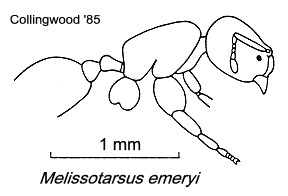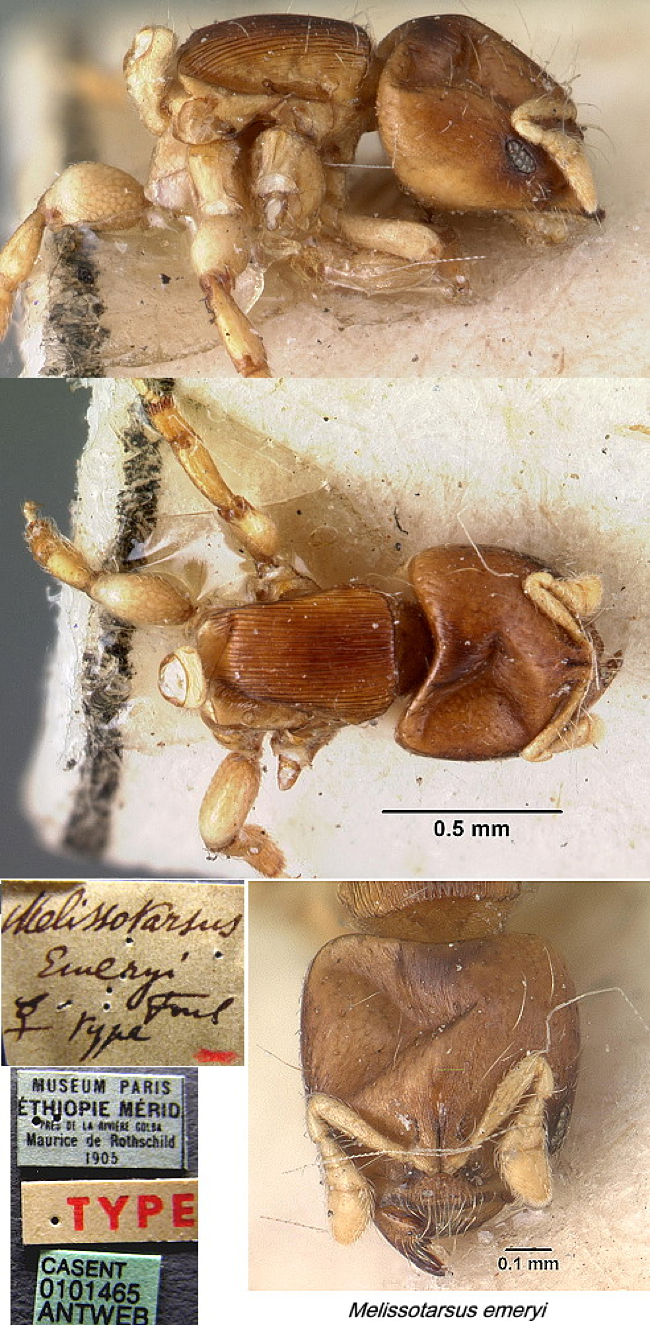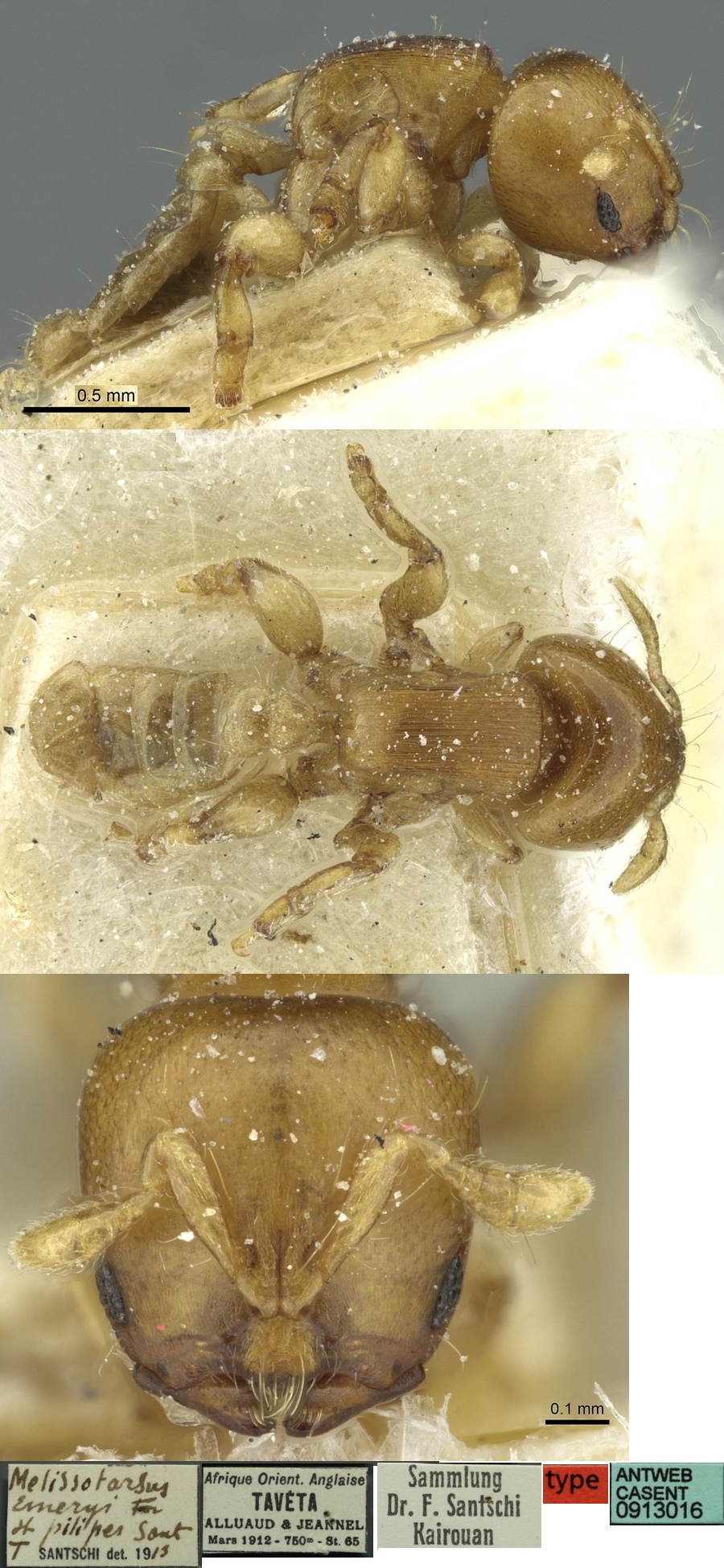Melissotarsus emeryi Forel
  Type location Ethiopia
(Melissotarsus Emeryi n. sp.,
Forel, 1907c: 133, worker; synonymy by Bolton, 1982: 335, also male
& queen) nr
R. Colba - see below Type location Ethiopia
(Melissotarsus Emeryi n. sp.,
Forel, 1907c: 133, worker; synonymy by Bolton, 1982: 335, also male
& queen) nr
R. Colba - see below
junior
synonyms
pilipes (Melissotarsus
Emeryi For. var. pilipes
nov., Santschi, 1914b: 71, worker) from Kenya, Taveta and Tanzania,
Kilimanjaro - see below
compressus (Melissotarsus
compressus new species, Weber, 1952: 1, illustrated, queen
only) from Central African Republic, Haut Mbo - no images on Antweb January 2019
(see
Bolton, 1982, 1995)  . .
|
 Forel's
(1907c) description is at Forel's
(1907c) description is at  . Santschi's (1914b)
description of pilipes
is at . Santschi's (1914b)
description of pilipes
is at  . Weber's (1952)
illustrated description of the compressus queen is at . Weber's (1952)
illustrated description of the compressus queen is at  . Bolton's modern description (1982) is at . Bolton's modern description (1982) is at  . In the wider text, page 335, Bolton had: M. emeryi and M. beccarii
have pale yellow sclerotised males and females in which the petiole in
dorsal view is quite broad (1.90-2.20 X broader than long). . In the wider text, page 335, Bolton had: M. emeryi and M. beccarii
have pale yellow sclerotised males and females in which the petiole in
dorsal view is quite broad (1.90-2.20 X broader than long).
|
 WORKER
- TL 2.5-3.4 mm; similar to beccarii but with the anterior
margin of the pronotum meeting the anterior declivity with a well
defined angle or edge. WORKER
- TL 2.5-3.4 mm; similar to beccarii but with the anterior
margin of the pronotum meeting the anterior declivity with a well
defined angle or edge.
Bolton (1982) felt that this and beccarii could
represent a single species, as intermediates are known.
From West Africa, apparently known solely from Ghana,
CRIG (C.A. Collingwood), according to Bolton (1982), but Wheeler (1922)
listed it from Senegal (at Thiès, by F. Silvestri); Bolton
also listed specimens from Popokabaka, Zaïre, by ES Ross & RE Leech.
Collingwood (1985) reporting it from Saudi Arabia (with
the illustration, right) from what he thought could be a relict
population in a small remnant of old woodland. he noted a number of
small colonies were found by scraping the bark of ancient, partially
collapsed, tamarisk trees; whereas in West Africa it occurs high up on
large forest trees and can only normally be discovered on felled trees.
The photomontage of the holotype is collated from http://www.antweb.org/specimen.do?name=casent0101465.
|
 The photomontage of the pilipes type is collated from http://www.antweb.org/specimen.do?name=casent0913016. The photomontage of the pilipes type is collated from http://www.antweb.org/specimen.do?name=casent0913016.
|
Oxford University Museum
specimens
Melissotarsus emery
B Taylor det.
Male
|
Central African
Republic
P Annoyer
QF bis
|
1.xii.2010
Dzanga-Sangha
2°28'49.5"N
16°12'55.9"E
|
392 m; 18h-19h,
Pendant l'ascension sur tronc de l'Azobé
|
1
|
 |
|
 The photomontage is of
a male from Central African Republic, Dzangha-Sangha NP;
collector P Annoyer (CAR QF bis) The photomontage is of
a male from Central African Republic, Dzangha-Sangha NP;
collector P Annoyer (CAR QF bis)
|
|